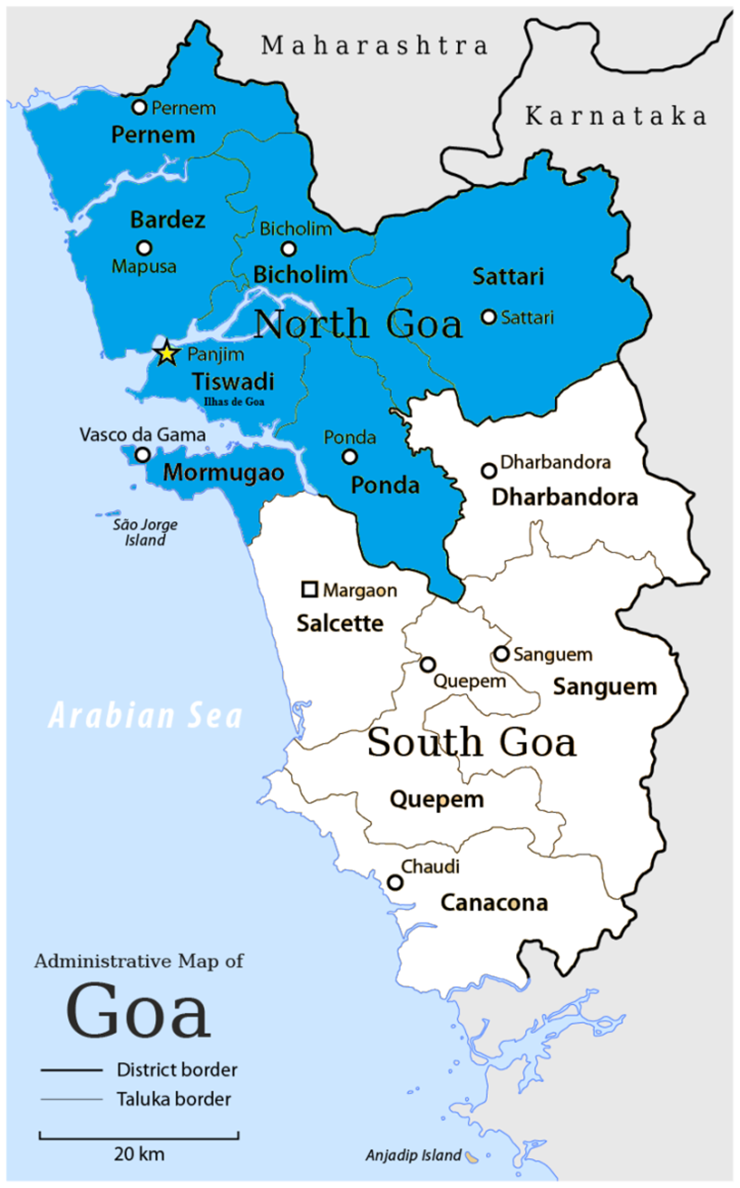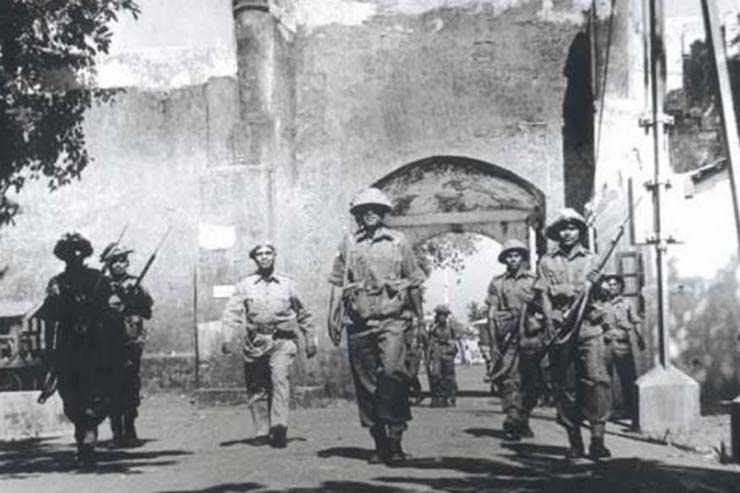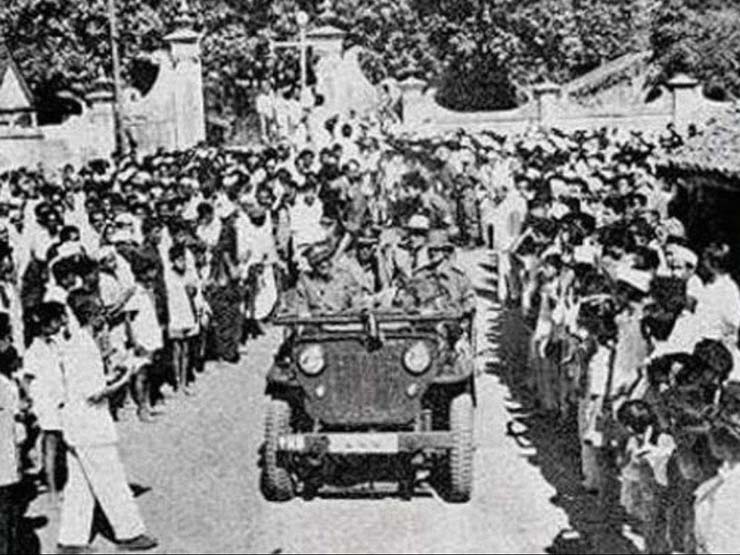 Goa is a tiny emerald land on the southwest coast of India in the Konkan region overlooking the beautiful Arabian Sea. It is a tropical paradise with natural scenic beauty, swaying palms, miles of golden sands, lush greenery, incredible cultural heritage, magnificent churches, temples and monuments witnessing a unique ethnic synthesis of East and West. Geographically, it is located in the coastal belt in the shadow of the Western Ghats of the Deccan Plateau. Goa remained under Portuguese rule for 450 years and became part of the Indian Union in 1961 as a union territory and fully fledged state on 30 May 1987. With a total area of 3702 sq km, it is the smallest state of India but has the best GDP per capita and quality of life among all Indian states. Its population is merely 18.2 lakh. The capital is Panaji. Vasco da Gama, Margao, Ponda and Mapusa are other important towns. P S Sreedharan is the Governor and Pramod Sawant is the Chief Minister of the state, which is divided into two districts North Goa and South Goa. Today, it is one of the best tourist destinations in the World all around the year with golden beaches, turquoise blue sea, active and safe nightlife, lovely bars and sumptuous seafood.
Goa is a tiny emerald land on the southwest coast of India in the Konkan region overlooking the beautiful Arabian Sea. It is a tropical paradise with natural scenic beauty, swaying palms, miles of golden sands, lush greenery, incredible cultural heritage, magnificent churches, temples and monuments witnessing a unique ethnic synthesis of East and West. Geographically, it is located in the coastal belt in the shadow of the Western Ghats of the Deccan Plateau. Goa remained under Portuguese rule for 450 years and became part of the Indian Union in 1961 as a union territory and fully fledged state on 30 May 1987. With a total area of 3702 sq km, it is the smallest state of India but has the best GDP per capita and quality of life among all Indian states. Its population is merely 18.2 lakh. The capital is Panaji. Vasco da Gama, Margao, Ponda and Mapusa are other important towns. P S Sreedharan is the Governor and Pramod Sawant is the Chief Minister of the state, which is divided into two districts North Goa and South Goa. Today, it is one of the best tourist destinations in the World all around the year with golden beaches, turquoise blue sea, active and safe nightlife, lovely bars and sumptuous seafood.
Goa was part of the great Mauryan empire under Ashoka the great in the 3rd century BCE and later it was under Chalkuyas between 578 to 763 CE, followed by Kadambas. It came under Vijay Nagar Empire in 1370 CE. Bahamanis-Bijapur took control in 1469 CE and ruled till 1510 CE. Vasco da Gama was the first Portuguese and European to land at Calicut on the Indian coast on 14 May 1498 and controlled the spice trade and later made Goa the first colonial traders/military base and finally defeated Yusuf Ali Shah with help of traitor Timoji by forces led by General Afonso de Albuquerque and established Portuguese colonial rule. Initially, in the 16th century, they established Velhas (old) conquests covering the area of subdivisions of Bardez, Salcette and Tiswad (Panjim area) and gradually acquired Nova’s conquests (New regions in depth) of Bicholim, Canacoa, Pernem, Quepem, Satatri and Sanguem. The entire territory was named Estado da India (Portuguese India) and included Goa, Daman and Diu.
After India’s independence in August 1947 from the British, it was assumed that the Portuguese would also depart but they continued holding the enclaves of the approximately 4000 sq km of the area of Goa, Daman, Diu and Nagar Haveli. The population was 61 per cent Hindus and 37 per cent Christians. There had been several underground movements, violent as well as non-violent, for the liberation of Goa. Most notable was the agitation by Ram Manohar Lohia, Brangca Cunha, Julio Menzes, Purushottam Kakodhar, and Laxmikant Bembre at Panjim against suspension of civil liberties and the group was arrested and jailed for six months. The United Front of Goa and Free Goa (Gomantak) Party cadres carried out armed attacks against Portuguese police. On 27 February 1950, the Indian government asked the Portuguese government to open negotiations for a peaceful gradual departure and merger of Goa in India but the Lisbon government refused and said blatantly that Estado da India was an integral part of Portugal. India withdrew its diplomatic mission from Lisbon on 11 June 1953 as a warning and also issued strict visa restrictions and banned transport movement to Goa, including shipping. Dadra and Nagar Haveli Police forces surrendered to Indian troops on 2 August 1954.
 Portuguese forces opened fire on 15 August 1955 as unarmed Indian activists forcefully tried to enter Goa borders and about 15 demonstrators were killed. India closed its Consul office on 1 September 1955. Portuguese Prime Minister Antonio Salazer suggested a referendum to determine its future. The proposal was rejected by Indian Prime Minister JL Nehru. The Portuguese PM approached the United Kingdom for mediation and finally applied to the UN Security Council for intervention. Indian Defence Minister Krishna Menon informed the UN that India had not abjured force so far but informed that Goa was an integral part of India and “we have a right to take action if the issue was not resolved.” US ambassador John Galbraith also requested India to resolve the matter peacefully. On 24 November 1961 ’Sabarmati’, an Indian passenger marine vessel was fired upon near Anjidiv island held by the Portuguese, which resulted in the death of a passenger and severe injuries to many, including the chief engineer. The incident had widespread reaction throughout the nation and the public demanded military action against the Portuguese. The parliament was rocked by the opposition as well as ruling party members. The die was cast for Military Option. On 10 December, Nehru made a statement in a special press conference that the ‘continuance of Goa under Portuguese rule is an impossibility’. An urgent meeting of the cabinet committee on security was held in the presence of service chiefs and the battle procedure commenced.
Portuguese forces opened fire on 15 August 1955 as unarmed Indian activists forcefully tried to enter Goa borders and about 15 demonstrators were killed. India closed its Consul office on 1 September 1955. Portuguese Prime Minister Antonio Salazer suggested a referendum to determine its future. The proposal was rejected by Indian Prime Minister JL Nehru. The Portuguese PM approached the United Kingdom for mediation and finally applied to the UN Security Council for intervention. Indian Defence Minister Krishna Menon informed the UN that India had not abjured force so far but informed that Goa was an integral part of India and “we have a right to take action if the issue was not resolved.” US ambassador John Galbraith also requested India to resolve the matter peacefully. On 24 November 1961 ’Sabarmati’, an Indian passenger marine vessel was fired upon near Anjidiv island held by the Portuguese, which resulted in the death of a passenger and severe injuries to many, including the chief engineer. The incident had widespread reaction throughout the nation and the public demanded military action against the Portuguese. The parliament was rocked by the opposition as well as ruling party members. The die was cast for Military Option. On 10 December, Nehru made a statement in a special press conference that the ‘continuance of Goa under Portuguese rule is an impossibility’. An urgent meeting of the cabinet committee on security was held in the presence of service chiefs and the battle procedure commenced.
Operation Vijay was the code name for Goa Liberation War. General P N Thapar was the Army Chief in 1961. He gave the task to Lt Gen Jayant Nath Choudhary (Southern Army commander). The 17 Infantry division commanded by Maj Gen K P Candeth was tasked to undertake swift ops and the 50 Indep Para Brigade commanded by Brig Sagat Singh was also additionally provided for Mainland Goa ops. Two battle groups were earmarked for Daman and Diu Sector. Air Vice Marshal Erlic Pinto, C-in-C Western Command was asked to coordinate air superiority and air support cover to advancing ground troops. Indian Navy completed the blockade led by INS Vikrant and four attack Task Forces.
Portuguese forces at Goa, Daman and Diu were under Governor-General M A Vassalo e Silva, who was under orders from Americo Tomas, the president of Portugal to fight the last man’s last bullet. The total military troops were approximately 4000 plus. The Navy consisted of a frigate with four 120mm guns and six patrol assault boats fitted with 20mm machine guns and five marine civil ships. There were also two squadrons of armoured cars and two batteries of L60 anti-aircraft guns protecting Dabolim Airport and Babolim Wireless station. Initially, it was reported there was a squadron of sabre jets but it was wrong information, but there were two super constellation Transport aircraft.
The mobilisation of Indian forces commenced on 11 December 1961. Naval and Air reconnaissance missions were initiated. The plan was to launch three-prong attacks with the target as Panaji. The main thrust was from the North led by the 50(I) Para Brigade and followed by another brigade as a reserve. The subsidiary was thrust from the East by the 63 Infantry Brigade and attached troops and diversionary attack from the South with a Battalion battle group. In the Northern sector, the attack commenced on three axes. The left or Eastern thrust was composed of 1 Armoured division and 2 Sikh LI which advanced on Perenum, Mapusa, Tivim, and Pahaji axis rapidly at the first light of 17 December 1961. This column was strongly contested by 1 Portuguese Reconnaissance squadron. The central column of the Northern thrust entered from Maulinguem led by 1 Para and advanced on the Basantari-Bicholim axis.
 The Portuguese 2nd Armoured squadron contested the advance. The bridges at Assonora, Chapora and Bicholim were blown up at 0400 am on 18 December to delay the rapid advance of Indian thrust lines. The right or Northeastern thrust line led by 2 Para and 7 Cavalry moved towards Ponda via the Valpol-Usgao axis. By 2100h, Indian tanks reached Betim ferry on the northern bank of Mandovi River followed by 2 Sikh LI by 1600h on 18 December. By 2000h, a delegation brought an offer of a ceasefire and surrender from Portuguese commander Major Acacio Tenereio to avoid undesired bloodshed and destruction. Indian troops reached Fort Aguada to take surrender. Portuguese troops opened heavy fire and two officers were killed. Brig Sagat Singh got annoyed and ordered the crossing of the Mandovi River by ferries and boats in the early hours of 19 December 1961. The 2 SIKH LI was the first unit to reach Panaji and hoisted the Tricolour at 0730 h and meanwhile, 7 Cavalry captured Fort Aguada at the same time.
The Portuguese 2nd Armoured squadron contested the advance. The bridges at Assonora, Chapora and Bicholim were blown up at 0400 am on 18 December to delay the rapid advance of Indian thrust lines. The right or Northeastern thrust line led by 2 Para and 7 Cavalry moved towards Ponda via the Valpol-Usgao axis. By 2100h, Indian tanks reached Betim ferry on the northern bank of Mandovi River followed by 2 Sikh LI by 1600h on 18 December. By 2000h, a delegation brought an offer of a ceasefire and surrender from Portuguese commander Major Acacio Tenereio to avoid undesired bloodshed and destruction. Indian troops reached Fort Aguada to take surrender. Portuguese troops opened heavy fire and two officers were killed. Brig Sagat Singh got annoyed and ordered the crossing of the Mandovi River by ferries and boats in the early hours of 19 December 1961. The 2 SIKH LI was the first unit to reach Panaji and hoisted the Tricolour at 0730 h and meanwhile, 7 Cavalry captured Fort Aguada at the same time.
The subsidiary thrust of the 63 Infantry brigade from the East also commenced advance on the Belgaum-Molem-Tisk-Ponda axis on the first light of 17 December 1961. The 2 Bihar and 3 Sikh linked up at Molem and captured Ponda town by last light. Borim Bridge was blown mid-night as the Indian Eastern thrust reached the Zuari River. The reserve battalion 3 Sikh waded through Juari River at Tembim Ford and reached Raia-Ambora road. The troops reached Margao town at 1200h on 18 December. Verna was captured after heavy resistance by 3 Sikh duly supported by 4 Sikh at 1530h on 19 December and Indian troops took control of Dabolim Airport and Morgugao port town by 2000h. The divisionary thrust was conducted by 4 Rajput from the South following the Bali-Sarzoa axis and reached Margao on 18 December.
 IAF Operations commenced on the first light of 18 December. The 12x Canberras fighter bombers led by Wing Commander N B Menon bombarded Dabolim Airport and discharged 63000 pounds of bombs and destroyed the runaway. The second Air raid was followed after a few hours by 8 Bombers. The third air raid by 6 Hawker Hunters destroyed the Wireless Station at Bambolim. Two transport aircraft loaded with civil officials, diplomats and families escaped at midnight and landed at Karachi Airport. The 45 Squadron of Vampires was used for the ground support role. IAF totally dominated the Goan Sky during the war.
IAF Operations commenced on the first light of 18 December. The 12x Canberras fighter bombers led by Wing Commander N B Menon bombarded Dabolim Airport and discharged 63000 pounds of bombs and destroyed the runaway. The second Air raid was followed after a few hours by 8 Bombers. The third air raid by 6 Hawker Hunters destroyed the Wireless Station at Bambolim. Two transport aircraft loaded with civil officials, diplomats and families escaped at midnight and landed at Karachi Airport. The 45 Squadron of Vampires was used for the ground support role. IAF totally dominated the Goan Sky during the war.
Naval Operations were planned by Rear Admiral B S Soman, FOC Indian fleet. Naval action started by establishing a total blockade from the Arabian Sea side. INS Vikrant was 60 km away with a support group to prevent any reinforcement or escape.
Portuguese frigate Alfonso de Alburquerque was the main target. It was stationed at the mouth of Morougao Port and was providing a vital radio link between Lisbon and Goa and firing constantly at Indian ships with 120 mm Naval Guns and 23 mm machine guns. INS Betwa and INS Beas with 4.5” Naval guns were awaiting orders to pound Alfonso. INS Betwa opened fire at 1200h at Alfonso on 18 December 1961 and also sent a signal by Morse code to surrender. Alfonso lifted anchor and opened up at a rapid rate at INS Betwa and Beas with 120mm shells. Alfonso fired almost 400 rounds. INS Betwa scored direct hits on Alfonso’s control tower killing the radio officer and injuring Captain Antonio Cunha. INS Beas also joined the battle. The propulsion system of Alfonso was also damaged. Consequently, the Frigate turned 180 degrees and was grounded.
The abandonment orders were passed at 1250 h and the crew started jumping out and escaping to the coast. The last escapees blew up the ship and dark smoke clouds could be seen from miles. Total Portuguese naval casualties were 5 dead and 13 wounded. Indian Marines suffered heavy casualties at a raid at Anjidiv island. 7 dead including 2 officers and 19 were severely wounded. The simultaneous operations were undertaken at Daman, 722 km away, and Diu island, 1379 km away from the mainland Goa on the gulf of Khambhat, southern Gujarat. All guns fell silent at 2030 h on 19 December 1961.
The war officially ended at 2030 h on 19 December 1961 as Governor-General Manual Antonio Vassalo signed the instrument of surrender bringing 451 years of Portuguese rule in Goa to an end. In the war, 4668 were taken as POWs. The total fatal casualties were 30 Portuguese troops and 20 Indian brave hearts. Thus, the unfinished task of the liberation of the last colonial enclave was completed. Estanda da India became the union territory of India on 20 December 1961 and Maj Gen K P Candeth was appointed as Military Administrator of Goa, Daman and Diu. The USSR, Sri Lanka, Egypt and African countries supported Indian action against a colonial power whereas the USA, UK and European countries criticised and termed it as an invasion. Portuguese broke all diplomatic relations with India. India achieved its aim with the liberation of the last foreign enclave on the Indian coastline after 14 years of Independence.
-The writer is an Indian Army veteran and a defence analyst. He has keen interest in Geo-strategic affairs and writes regularly on internal and external affairs issues related to India and neighbours. The views expressed are personal and do not necessarily reflect the views of Raksha Anirveda








